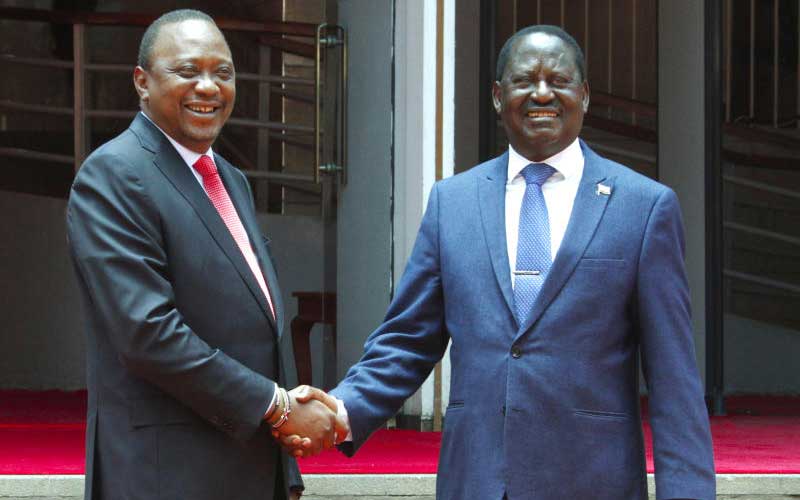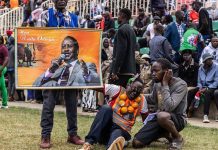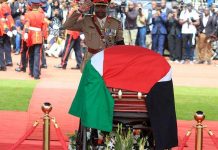Written by
Faridah N Kulumba
Africa-Press – Kenya. It is now in the open that Kenyan President Uhuru Kenyatta is pushing for his brother and leader for Orange Democratic Movement Party Raila Odinga as his successor when he retires in 2022.
This followed Uhuru pressuring One Kenya Alliance (OKA) principals to drop their ambitions and support Odinga for the presidency in the upcoming 2022 general elections during a meeting he held at the State House in Mombasa.
On Tuesday 10, 2021, President Uhuru held a meeting with all opposition Chiefs where he urged them to unite against his Deputy President William Ruto, and support Odinga’s presidential candidature in next year’s elections, The Daily Post reported.
The party leaders who were met including Kalonzo Musyoke (Wiper), Gideon Moi (KANU), Moses Watang’la (Ford Kenya), Alfred Mutua (Machakos Governor) and Kivutha Kibwana (Makueni Governor)
Background
On 09 March 2013, President Uhuru and his deputy William Ruto wore broad smiles when they stood on stage. Against all odds, their Jubilee coalition had been declared the winner of the presidential election.
Ruto called their victory a miracle, saying God had turned insurmountable hurdles into bridges for their coalition, BBC reported.
In the early days President Uhuru and his Deputy walked together, sometimes hand in hand, and worked in sync, smiled, played and at times dressed alike.
Life was moving smoothly between the two. When they first assumed office Uhuru was 51 while Ruto was 47 and the man they had defeated former Prime Minister Raila Odinga was 68 and was branded old and of the analogue generation that defined Kenya’s dark and forgettable past, while Uhuru and Ruto were defined in modern terms as digital team.
Change of plans
President Kenyatta’s relationship with his deputy and his successor Ruto took a turn, when Jubilee entered a pact with opposition leader Raila Odinga of Orange Democratic Movement.
On 19 March 2018, Kenya’s president Kenyatta and Raila Odinga shook hands in a symbolic gesture that ended months of tensions following the disputed election in 2017 that gave Kenyatta a second term.
Popularised as the “handshake,” the agreement has caused major rifts within the ruling party since it ushered in the Building Bridges Initiative (BBI).
Those to Deputy President Ruto accused Odinga of “hijacking” Jubilee Party for political interests, while proponents of the handshake and the BBI fault Ruto’s allies for curtailing Kenyatta’s initiative to unite Kenyans.
Today, the strain between the two Kenyan top leaders is displayed openly, with Ruto working hard to be the next Kenyan president and Uhuru pushing for Odinga to succeed him.
When the two joined forces, they had an unwritten 20-year prenuptial agreement, in which Ruto would back Mr Kenyatta to serve as president for two year terms. After that Mr Kenyatta would reciprocate by supporting his deputy to win the presidency in the 2022 election and he too would serve for two terms.
But in January 2021 Kenyatta gave the clearest declaration that the deal was dead.
Reasons revealed
According to Uhuru’s allies, the president wants Odinga to succeed him to end the political feud between Jomo Kenyatta’s family and that of Jaramogi Oginga Odinga.
Besides, Uhuru wants to leave a united country and that will only be achieved if Odinga succeeds him.
Jubilee Vice-Chairman, David Murathe, an ardent defender of President Uhuru said that it is only through Odinga’s presidency that Uhuru will leave the country united and leverage on the gains made by the Jubilee government.
“We are determined to have Raila get a Mandela moment, we are keen on this and it will happen,” Murathe said.
State House gatekeepers have consistently maintained that Uhuru is keen to ensure the handshake spirit lives even after his retirement.
During the 1 June Independence Day President Uhuru declared that he had made bigger strides in terms of development during his time with Odinga than with his deputy Ruto.
And in January 2021 Uhuru while ending the succession deal with Ruto told the public that the presidency does not belong to only two tribes, adding that it was perhaps time for another of Kenya’s 42 ethnic groups to take over.
He noted that only members of two communities have occupied the top seat in Kenya, the Kikuyu and the Kalenjin. Uhuru is a Kikuyu, Ruto is a Kalenjin while Odinga is from the Luo community, which has long complained about being excluded from power.






